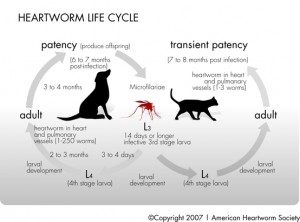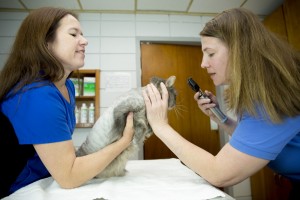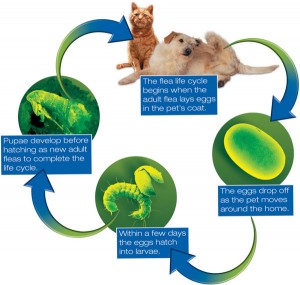Just as annual physical exams are recommended for humans, they are recommended for our pets as well. If your pet is older or has medical problems, he may need even more frequent examinations. A year is a long time in a pet’s life. Assuming our pets will live to their early teens, receiving a yearly exam means they will only have about thirteen exams in a lifetime. That is not very many when you think about it.
During your pet’s annual physical exam you should review these aspects of your pet’s health with your veterinarian:
- Vaccination status – Consult with your veterinarian to determine which vaccinations your dog should receive, and how often.
- Parasite control for intestinal parasites, fleas, ticks, mites, and heartworms
- Dental health – care you give at home; any mouth odors, pain, or other signs of disease you may have observed
- Nutrition – including what your dog eats, how often, what supplements and treats are given, and changes in water consumption, weight, or appetite
- Exercise – how much exercise your pet receives including how often and what kind; and any changes in your pet’s ability to exercise
- Ears and Eyes – any discharge, redness, or itching
- Stomach and intestines – any vomiting, diarrhea, constipation, gas, belching, or abnormal stools
- Breathing – any coughing, shortness of breath, sneezing, or nasal discharge
- Behavior – any behavior problems such as barking, ‘accidents,’ or changes in temperament
- Feet and legs – any limping, weakness, toenail problems
- Coat and skin – any hair loss, pigment changes, lumps, itchy spots, shedding, mats, or anal sac problems
- Urogenital – any discharges, heats, changes in mammary glands, urination difficulties or changes, neutering if it has not already been performed
- Blood tests – an annual heartworm disease snap test, wellness panels for geriatric pets, any of those with medical problems, and pets who are receiving on going medications may be recommend
All pets are at risk for potentially deadly heartworm disease. Heartworms live in the heart and blood vessels of the lungs of dogs, cats and other mammals like wolves, foxes and coyotes. Heartworms cannot be spread directly from animal to animal without a mosquito as an intermediary. Heartworms are spread when a mosquito bites an infected pet and picks up tiny larvae called microfilariae from the bloodstream.
Then that mosquito bites another pet infecting it with the heartworm larvae. Over the next several months the heartworm larvae grow and migrate to the heart and lungs. These larvae mature into adults, which can be a foot in length, and they produce microfilariae that circulate in the bloodstream. Now this pet’s a reservoir of heartworms and is ready for another mosquito to bite and infect yet another pet.
Untreated, heartworm disease can lead to severe problems with the heart, lungs, liver and kidneys and may result in death.
One mosquito bite is all it takes for your dog to get heartworm disease.
The Heartworm life cycle
1. A mosquito bites an infected pet and ingests tiny heartworm larvae along  with the animal’s blood. Other carriers of heartworm disease include wolves, foxes, ferrets, coyotes and raccoons.
with the animal’s blood. Other carriers of heartworm disease include wolves, foxes, ferrets, coyotes and raccoons.
2. Inside the mosquito, these larvae develop into their infective stage.
3. When the same mosquito bites another pet, the larvae infect the healthy animal.
4. Without a monthly dose of preventive, the larvae continue to develop inside the pet, eventually reaching the heart and lungs.
Common Misconceptions About Heartworms
- MYTH : Indoor pets are not at risk
- FACT: Heartworms are spread by mosquitoes. One mosquito bite is all it takes for a pet to be infected. All pets are at risk.
- MYTH : Only pets in heartworm epidemic areas like southeastern states need protection against heartworms
- FACT: Heartworm disease has been reported in all 50 states. One million pets are estimated to be heartworm positive in the United States each year.1 The disease continues to spread to new regions. The best way to protect your pet is to administer a heartworm preventive year-round as directed by your veterinarian.
- MYTH : Treatment for heartworm disease is just as easy as preventing it.
- FACT: Treatment requires arsenic-based injections to kill the heartworms living in a pet’s lungs and heart. In comparison to heartworm prevention, the treatment is expensive and can be traumatic and risky. Currently there is not any treatment available for felines that have contracted the disease. It is much easier to prevent heartworms than to treat them.
Fleas 101:
Contrary to some, fleas are a common problem in our area. Besides causing medical
problems in our pets, i.e. allergies, fleas are a source of one of the internal parasites
(tapeworms) in dogs and cats. Flea denial is a real problem if you don’t see a flea on your
pet, you don’t have fleas. Not so much. We tend to focus on the adult and don’t consider the flea eggs, larvae and pupae stages. Treating our pets for fleas requires constant year round application of the flea medicine. Once we stop treating for fleas, we invite the fleas back into our homes and on to our pets.
The Flea life cycle:
1. Female fleas begin feeding on pets within minutes and lay 40-50 eggs per day.
2. Larvae take 5-12 days to develop into pupae.
3.Fleas emerge from pupae anywhere from 14-180 days.
4. Temperature and humidity drive flea population growth
Common Misconceptions About Fleas
Because there are multiple veterinary flea products, fleas are becoming
resistant to the older products.
• Switching products is effective because it exposes fleas to new chemicals.
• You should not see ANY fleas on your pet if they are treated with a veterinary
flea product.
• Indoor cats can not get fleas.
• Spraying the yard with insecticides and using flea foggers in the home will
control fleas in the environment.
• In many parts of the country, autumn, not summer, is when flea populations
are highest.
• I don’t have carpets in my house, therefore I can’t have fleas (they live in the
cracks).




